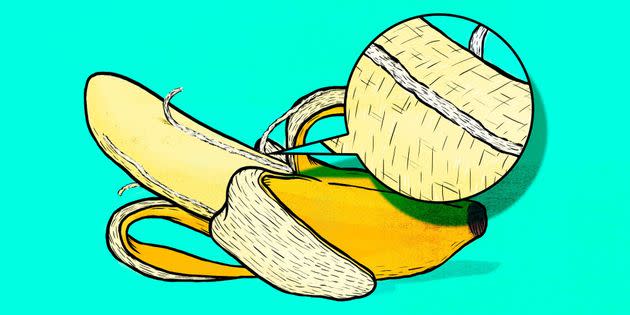FYI, Those Annoying White Strings On Bananas Actually Have A Purpose

Leathery strings of unpleasantness.
Pull back the yellow peel of a banana, and there they are, haunting you. They run vertically along the fruit, demanding to be removed with precision. They dangle lifelessly from the flesh of ripe bananas, but cling mercilessly to those that are less ripe. Either way, they are never wanted.
We’re talking about those annoying white strings on bananas, or more technically, “phloem bundles.” (Appetizing name, right?)
Anyone who’s peeled a banana has certainly encountered this unpleasantness. But what do we even know about these things?
If the term “phloem” sounds familiar to you, it’s probably because you were taught about phloem and xylem when you learned about plant biology in middle school science class. Those two terms describe the complex tissues that transport food and water in a plant, providing it with sufficient food, nutrients, minerals and water to grow.
So essentially, these hideous strings distribute nutrients up and down the banana as it grows, allowing us to eat the delicious bananas that we so love.
Some people hate phloem bundles so much that they’ve dedicated blogs to the subject. Many of us don’t give them much thought, accepting them as just another tedious part of our daily lives. But is there more we need to know? Only a banana doctor could tell us.
To get some answers, we talked to Nicholas D. Gillitt, who has a Ph.D. in physical/inorganic chemistry and is the VP of nutrition research and director at the Dole Nutrition Institute.
HuffPost: Is there any nutritional difference between phloem bundles and the rest of the edible part of the banana?
Gillitt: “Although we have not specifically tested phloem bundles, it is likely that there would be a difference in its nutritional value. Since they are intended to do a specific job, and as such likely have a defined structure which supports that job, they would be expected to have a different compound profile to the regular edible banana flesh. They likely contain more and varied types of fiber and structural components required for their function. Because of this, they probably would have a different nutritional profile for humans.
“They are, however, present in such small amounts compared to the rest of the banana, that unless you eat a large amount of them individually, they would not be expected to impact the overall nutrition profile of a banana.”
Are phloem bundles safe to eat?
“As part of the banana, of course! Now, [whether they] are palatable is another question.
“In general, all parts of fruits are healthy. We eat the skins of apples, pears, etc., and we could eat the skins of bananas — including the phloem bundles — if we find them palatable, but there is no evidence to suggest they are harmful.”
Then are they good for us?
“Any fiber is healthy.”
What sort of feedback do you get about banana strings?
“In general, Dole has not received any meaningful consumer complaints on phloem bundles. From a scientist’s perspective — who has conducted several clinical trials with hundreds of subjects eating large quantities of bananas during studies — I can categorically state I have not been made aware of one instance where a subject thought these phloem bundles were bothersome.”
Is it even possible to develop a banana without phloem bundles?
“Yes it is potentially possible, but if the phloem bundles are necessary for the adequate disposition of nutrients throughout the plant, and are not truly bothersome, what would be the driver? From a company mission perspective of broadening access to nutrition and healthier eating, we would feel it is a much more important extension of resources to spend research money on breeding disease-resistant or increased nutrient content varieties.”
Consider us told.

